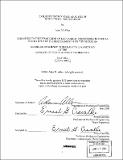| dc.contributor.advisor | Ernest Cravalho. | en_US |
| dc.contributor.author | Allen, Aden M. (Aden Martin), 1980- | en_US |
| dc.contributor.other | Massachusetts Institute of Technology. Dept. of Mechanical Engineering. | en_US |
| dc.date.accessioned | 2006-03-24T16:05:11Z | |
| dc.date.available | 2006-03-24T16:05:11Z | |
| dc.date.copyright | 2002 | en_US |
| dc.date.issued | 2002 | en_US |
| dc.identifier.uri | http://hdl.handle.net/1721.1/29588 | |
| dc.description | Thesis (S.B.)--Massachusetts Institute of Technology, Dept. of Mechanical Engineering, 2002. | en_US |
| dc.description | Includes bibliographical references. | en_US |
| dc.description.abstract | An estimation of the energy yielded from the explosion created by the crash of United Flight 175 into the World Trade Center was conducted to rule out the possibility of other explosive elements (i.e. a bomb) on board. The amount of fuel ignited and the corresponding energy yielded by the fireball was estimated by studying videotapes of the crashes. The calculated volume of fuel vapor, which is consumed to form the fireball, is a fraction of the estimated total fuel aboard the plane upon impact. Due to thermal expansion, the fuel vapor quickly expands forming a high fuel/air mixture and ignites. The energy yield from combustion estimated from the videos using maximum rise height and burning time corresponds with a rough initial estimate of the energy yield using a fraction of the volume of fuel estimated on board the plane at impact. A conservative estimate of the energy released by TNT explosives is significantly less than the energy yielded by the jet fuel aboard the plane. Therefore, the presence of explosives on the plane is highly unlikely. In addition, although a bomb would not contribute significantly to the energy yielded, it is hypothesized that one could have been used to ensure that the fuel ignited after impact. This would also be unnecessary because the material properties of the fuel makes ignition almost certain. Recommendations for future studies are to develop methods of flying that have lower energy potential, to examine how a plane breaks apart during impact, and to prevent ignition of jet fuel when released. | en_US |
| dc.description.statementofresponsibility | by Aden M. Allen. | en_US |
| dc.format.extent | 16 leaves | en_US |
| dc.format.extent | 434133 bytes | |
| dc.format.extent | 433950 bytes | |
| dc.format.mimetype | application/pdf | |
| dc.format.mimetype | application/pdf | |
| dc.language.iso | eng | en_US |
| dc.publisher | Massachusetts Institute of Technology | en_US |
| dc.rights | M.I.T. theses are protected by copyright. They may be viewed from this source for any purpose, but reproduction or distribution in any format is prohibited without written permission. See provided URL for inquiries about permission. | en_US |
| dc.rights.uri | http://dspace.mit.edu/handle/1721.1/7582 | |
| dc.subject | Mechanical Engineering. | en_US |
| dc.title | Explosive energy yield analysis of World Trade Center crash | en_US |
| dc.type | Thesis | en_US |
| dc.description.degree | S.B. | en_US |
| dc.contributor.department | Massachusetts Institute of Technology. Department of Mechanical Engineering | |
| dc.identifier.oclc | 52906608 | en_US |
